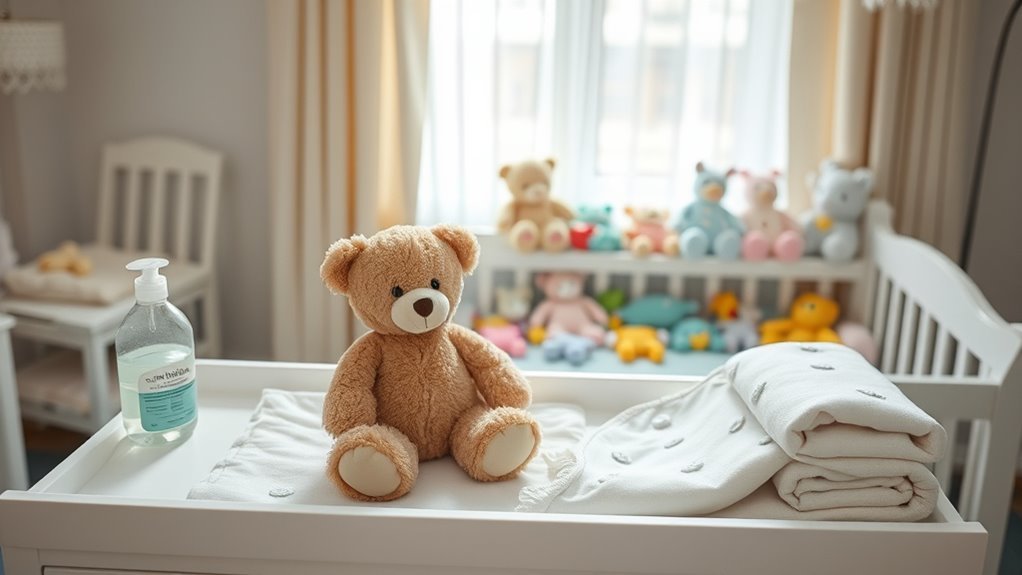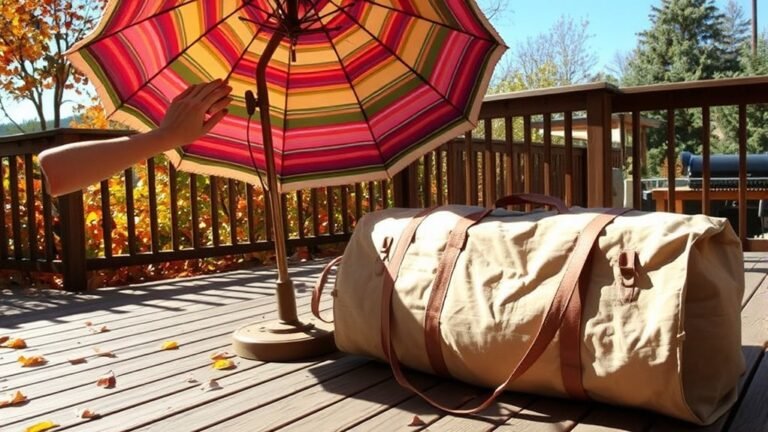Top 10 Tips for Cleaning Baby Items
You’ll want to choose gentle, natural cleaning products to protect your baby’s sensitive skin and immune system. Regularly sterilize bottles and feeding accessories using steam methods, and wash baby clothes with hypoallergenic detergents, avoiding fabric softeners. Sanitize toys and diaper changing areas with safe, natural disinfectants like vinegar. Clean pacifiers and teething rings thoroughly each week, and always dry bath items after use. Store everything in breathable containers to prevent mold and bacteria buildup. Keep following these tips for a safe, hygienic environment tailored to your little one’s needs.
Choose the Right Cleaning Products for Baby Items
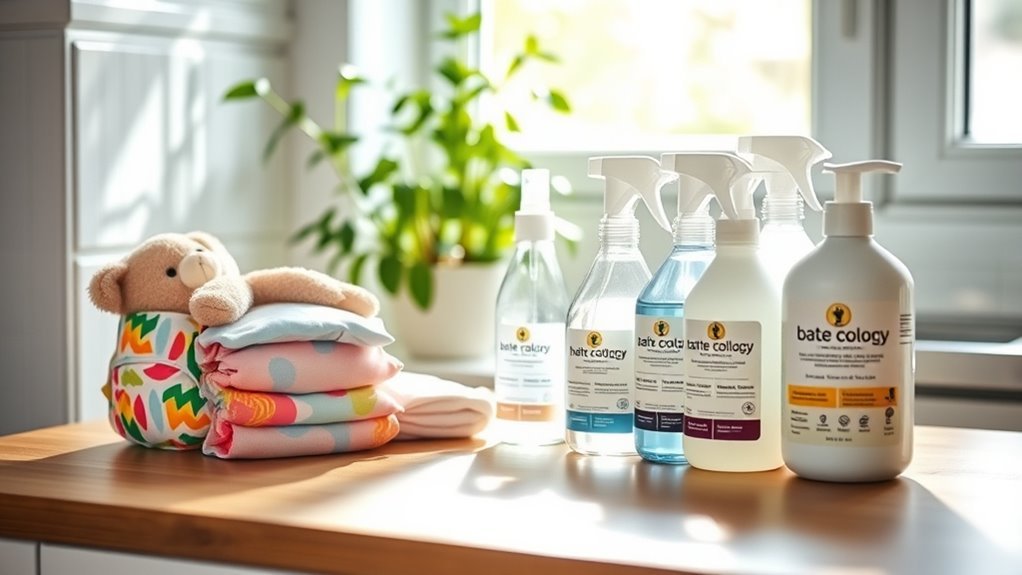
When it comes to cleaning baby items, choosing the right products is essential because your little one’s health depends on it. You want to avoid harsh chemicals that can irritate sensitive skin or harm your child’s developing immune system. Opt for natural alternatives like plant-based soaps and vinegar solutions, which effectively clean without toxic residues. Integrating these into your cleaning routines not only protects your baby but also supports your desire for a safer, more natural environment. Remember, consistency is key; establish simple, regular cleaning habits that keep items hygienic without overwhelming your daily life. By selecting gentle, effective products, you’re ensuring your baby’s safety while embracing the freedom to care for them naturally and confidently.
Sterilize Bottles and Feeding Accessories Regularly
Since baby bottles and feeding accessories come into direct contact with your little one’s mouth, sterilizing them regularly is essential to prevent harmful bacteria and germs from causing infections. You’ll want to clean each item thoroughly with bottle brushes to reach every nook and cranny before sterilizing. Steam sterilization is one of the safest and most effective methods—it uses high-temperature steam to eliminate bacteria without harsh chemicals. You can choose electric steam sterilizers or microwave steam bags, both designed to fit your busy lifestyle and give you peace of mind. Keep in mind, regular sterilization isn’t just about cleanliness; it’s about protecting your baby’s health and freedom to explore without worry. Make sterilizing a simple, consistent part of your routine—you and your baby deserve it.
Wash Baby Clothes With Gentle Detergents
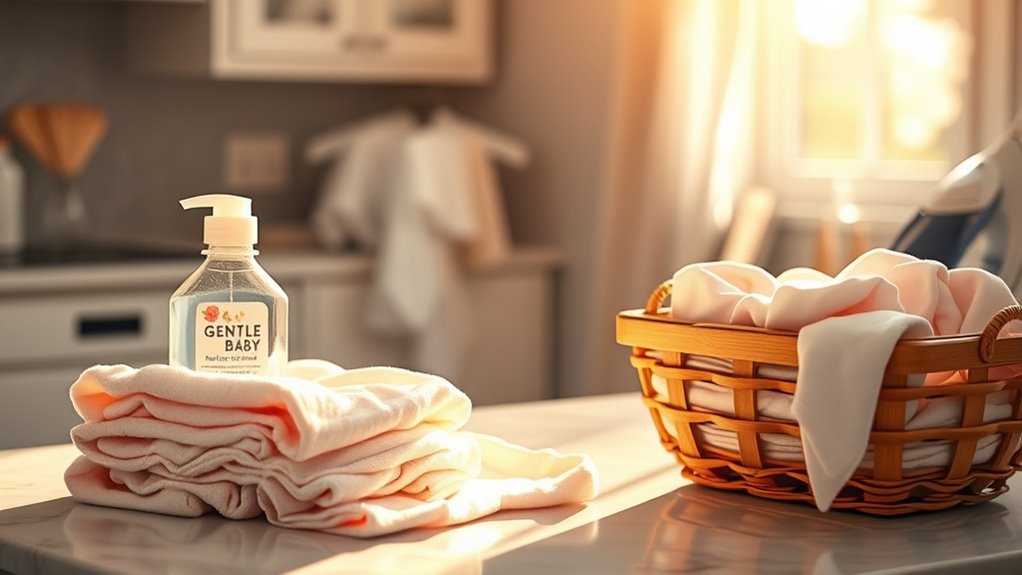
Although baby skin is delicate and sensitive, you don’t have to worry about harsh chemicals irritating it if you choose gentle detergents designed specifically for infants. These detergents offer numerous gentle detergent benefits, including hypoallergenic formulas and free from dyes or fragrances, ensuring your baby’s clothes stay soft and safe. Proper baby fabric care helps prevent rashes and skin irritation, giving you peace of mind while maintaining fabric quality.
| Gentle Detergent Benefits | Baby Fabric Care Tips |
|---|---|
| Hypoallergenic | Use cold water washes |
| Free of dyes & fragrances | Avoid fabric softeners |
| Biodegradable | Choose delicate wash cycles |
| Maintains fabric softness | Rinse thoroughly to remove residue |
| Controls odors gently | Air dry to preserve fabric |
Choosing the right detergent means freedom from worry and comfort for your little one.
Sanitize Toys Safely and Effectively
Keeping your baby’s toys clean is essential for their health and safety, and there are several effective methods you can use to sanitize them without causing damage. You can rely on natural disinfectants like diluted vinegar or a mild solution of water and baking soda to safely eliminate germs. Avoid harsh chemicals, which might irritate your little one or harm toy materials. After cleaning, make sure to dry toys thoroughly before placing them back into toy storage to prevent mold growth. Regularly sanitize toys, especially those your baby frequently mouths or shares with others. By maintaining a clean play environment with safe sanitizing practices, you help protect your baby’s health while giving yourself the freedom to trust the toys are safe and ready for playtime.
Clean Pacifiers and Teething Rings Thoroughly
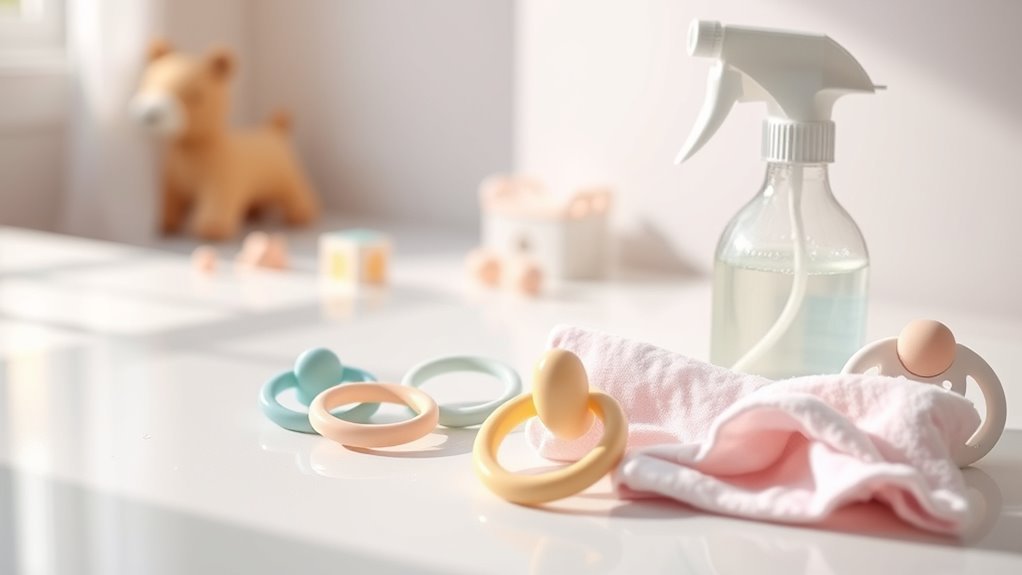
You need to clean pacifiers and teething rings thoroughly to keep your baby safe from harmful germs. Using proper sterilization methods regularly and choosing safe cleaning products are key to preventing infections. Let’s explore how often you should clean these items and the best techniques to use.
Proper Sterilization Methods
Since pacifiers and teething rings come into direct contact with your baby’s mouth, it’s essential to sterilize them properly to prevent harmful bacteria buildup. One of the most reliable sterilization techniques is using boiling water. Simply place these items in boiling water for about five minutes to kill germs effectively. Make sure the items are fully submerged and avoid overcrowding the pot to guarantee even sterilization. After boiling, let them cool naturally on a clean surface before use. Alternatively, you can use a steam sterilizer or microwave sterilizer designed for baby items if you prefer quicker methods. Remember, proper sterilization keeps your baby safe without complicating your routine, giving you the freedom to focus on what truly matters—your little one’s health and happiness.
Frequency of Cleaning
Regularly cleaning pacifiers and teething rings is essential to prevent the buildup of germs that can affect your baby’s health. Sticking to a consistent cleaning schedule guarantees these items remain safe and hygienic. Frequency guidelines recommend washing them daily and sterilizing weekly or after each use if your baby is sick. This approach balances safety with your need for freedom from constant worry.
| Item | Cleaning Frequency |
|---|---|
| Pacifiers | Daily washing, weekly sterilization |
| Teething Rings | Daily washing, weekly sterilization |
| After Illness | Sterilize immediately |
| Visible Dirt | Clean immediately |
Safe Cleaning Products
Although it might seem straightforward, choosing the right cleaning products for your baby’s pacifiers and teething rings is essential to confirm thorough sanitation without exposing them to harsh chemicals. You want to protect your little one from harmful residues, so opting for eco friendly cleaners or natural alternatives is a smart move. These products effectively eliminate germs while being gentle on delicate baby items. You can also consider simple solutions like a mixture of vinegar and water or baking soda, which are safe and easy to use. Always rinse items thoroughly after cleaning to remove any traces of cleaner. By selecting safe cleaning products, you confirm your baby’s comfort and health, giving you peace of mind while maintaining freedom from harsh chemicals.
Maintain a Clean Sleeping Environment
When you create a clean sleeping environment for your baby, you’re not just promoting hygiene—you’re also supporting their health and comfort. Prioritizing sleeping safety means regularly washing crib sheets, mattress covers, and any soft bedding with gentle, baby-safe detergents. Keep the crib free from dust and allergens by wiping down rails and slats often, ensuring crib hygiene is maintained. Avoid cluttering the sleep area with toys or pillows that could pose a suffocation risk. Ventilate the room to reduce moisture and prevent mold growth, which can impact your baby’s breathing. By establishing these simple, consistent habits, you’re giving your baby a safe, fresh space to rest peacefully, allowing both of you to enjoy freedom from worry and the peace of mind you deserve.
Use Proper Techniques for Cleaning Baby Gear
Since baby gear comes into frequent contact with your little one, you’ll want to clean it thoroughly and correctly to keep germs and irritants at bay. Establishing consistent cleaning schedules helps you stay on top of gear maintenance without feeling overwhelmed. For fabrics like car seat covers and stroller cushions, follow manufacturer instructions—usually gentle machine washes work best. Hard surfaces, like high chairs and playpens, should be wiped down with mild soap and warm water, avoiding harsh chemicals that can irritate your baby’s skin. Regularly inspect each item for wear and tear during cleaning, ensuring everything remains safe and functional. By using proper techniques and sticking to a maintenance routine, you create a healthier environment for your child while freeing yourself from constant worry about cleanliness.
Disinfect Diaper Changing Areas Frequently
You’ll want to disinfect diaper changing areas frequently to keep your baby safe from germs. Use safe cleaning products, wipe down surfaces after each change, and make sure to sanitize changing pads regularly. Staying consistent with these steps helps maintain a clean and healthy environment for your little one.
Use Safe Cleaning Products
Although diaper changes are a routine part of caring for your baby, it is crucial to disinfect the changing area regularly using safe cleaning products. You want to protect your little one from harmful chemicals while maintaining a clean environment. Opt for natural alternatives like vinegar, baking soda, or plant-based cleansers that effectively eliminate germs without exposing your baby to toxins. Eco friendly options not only safeguard your child’s health but also reduce your environmental footprint, giving you peace of mind. Remember, choosing safe products means you’re prioritizing both your baby’s wellbeing and your family’s freedom from harsh chemicals. By making mindful choices, you create a safer space for diaper changes and support a cleaner, healthier planet for your child to grow up in.
Clean Surfaces After Each Change
Every diaper change calls for a quick wipe-down of the surfaces you’ve used. Maintaining surface hygiene reduces germs and keeps your baby’s environment safe. By disinfecting diaper changing areas frequently, you protect both your little one and yourself from unwanted bacteria. It’s a simple step that fits seamlessly into your change time routine, ensuring freedom from worry.
| Step | Why It Matters |
|---|---|
| Wipe immediately | Prevents germ buildup |
| Use baby-safe wipes | Protects sensitive skin |
| Disinfect regularly | Kills harmful bacteria |
| Dry surfaces | Avoids moisture-related issues |
Make cleaning a non-negotiable habit every change time. Your baby’s health and your peace of mind depend on it.
Regularly Sanitize Changing Pads
Since changing pads are a frequent contact point for your baby, regularly sanitizing them is vital to prevent the spread of germs and protect your child’s delicate skin. Different changing pad materials require specific sanitize methods—vinyl pads can be wiped down with a gentle disinfectant, while fabric covers often need machine washing with baby-safe detergents. Always check manufacturer guidelines to avoid damage. Using a mild, non-toxic sanitizer guarantees safety without harsh chemicals. Between thorough cleanings, quick wipe-downs after each diaper change can maintain hygiene effortlessly. Prioritizing this routine keeps your baby’s changing area fresh, reducing infection risks while giving you peace of mind. Regular sanitation isn’t just about cleanliness—it’s about creating a safe, healthy space that supports your baby’s wellbeing every day.
Clean Baby Bath Items After Each Use
When you clean baby bath items after each use, you reduce the risk of harmful bacteria and mold buildup that can affect your little one’s health. It’s essential to rinse and dry baby bath toys thoroughly, as they often trap water inside, creating a breeding ground for germs. Squeeze out any water and wipe the surfaces clean to maintain excellent bath time hygiene. Pay attention to sponges, washcloths, and bath seats, too—rinse them well and let them air dry completely. By making this a simple, consistent habit, you protect your baby from infections and create a safer, more enjoyable bathing experience. Cleaning bath items promptly keeps things fresh and hassle-free, giving you more freedom to focus on bonding with your baby during bath time.
Store Baby Items in a Hygienic Way
Properly storing baby items is just as important as cleaning them to keep your little one safe from germs and contaminants. To maintain hygiene, choose storage solutions that allow air circulation and prevent moisture buildup, like open baskets or breathable containers. Avoid airtight plastic bags, which can trap bacteria and mold. Organization tips such as labeling bins and categorizing items by use will help you find essentials quickly, reducing unnecessary handling. Keep items off the floor and away from direct sunlight to preserve their cleanliness and quality. Regularly inspect storage areas for dust or pests, and clean shelves and containers routinely. By implementing these practical storage strategies, you create a safe, accessible environment that supports your baby’s health while giving you the freedom to manage care with confidence.
Frequently Asked Questions
How Often Should I Replace Baby Bottles and Nipples?
You should replace baby bottles every 3 to 6 months to guarantee safety and hygiene, as the bottle lifespan varies with usage and material. Nipples need more frequent attention; check them regularly for cracks or changes in texture since nipple durability affects your baby’s feeding experience and safety. If you notice any signs of wear or damage, swap them out immediately. Staying on top of this helps you feel confident and free from worry during feeding times.
Can I Use Natural Cleaning Products for Baby Items?
You can definitely use natural cleaning alternatives for your baby items, but you’ll want to guarantee they’re safe and effective. Look for products free from harsh chemicals, fragrances, and dyes to protect your little one’s health. Ingredients like vinegar, baking soda, and mild castile soap are great options. Always rinse thoroughly to avoid residue. Prioritizing baby product safety lets you clean confidently while embracing a more natural, toxin-free lifestyle for your family.
What Is the Best Way to Clean Cloth Diapers?
Think of cloth diapers as tiny guardians of your baby’s comfort—they need gentle, consistent care to stay effective. For the best cloth diapering techniques, rinse solids off promptly and wash every 2-3 days to prevent odors and stains. Use a mild detergent without fabric softeners, and choose a hot water cycle to deeply cleanse. Air-drying them not only preserves their absorbency but also honors your freedom to nurture naturally and sustainably.
How Do I Remove Stubborn Stains From Baby Clothes?
When tackling stubborn stains on baby clothes, first consider the fabric types—delicate materials need gentler care. You’ll want to act quickly; pre-treat stains with a safe stain removal solution or a mix of water and mild detergent. Gently rub the spot, then wash as usual. Avoid harsh chemicals to protect sensitive skin. Remember, patience is key, and with the right approach, you can keep those tiny outfits fresh and stain-free without hassle.
Is It Safe to Microwave Sterilize Baby Items?
You can safely use microwave sterilization for baby items, but it’s important to follow safety guidelines closely. Make sure the items are microwave-safe and use a designated microwave sterilizer or steam bags designed for this purpose. Avoid metal parts and always check your microwave’s instructions. This method is quick and effective, giving you freedom from lengthy cleaning routines while ensuring your baby’s items stay germ-free and safe.
